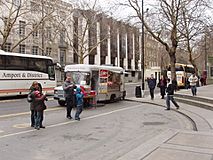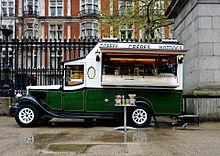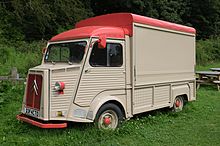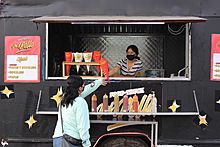Food truck facts for kids
A food truck is a big vehicle, like a van or a trailer, that has a kitchen inside. It's used to cook, prepare, serve, and sell food. Some food trucks, like ice cream trucks, sell food that's already made or frozen. Others have full kitchens and cook meals right there! They might also heat up food made in a regular restaurant kitchen.
You can often find popular foods like sandwiches, hamburgers, and french fries. In the early 2010s, food trucks became very popular for selling fancy, "gourmet" food and different kinds of international dishes. They also sell drinks like soda and water. Food trucks are a big part of the street food world, which feeds billions of people every day!
History of Food Trucks
Food trucks have a long and interesting history, especially in the United States.
Early Days in the United States
One of the first ideas for a food truck was the Texas chuckwagon. In the late 1800s, cowboys herded cattle across long distances. In 1866, a rancher named Charles Goodnight turned an old army wagon into a kitchen on wheels. He filled it with cooking tools, food like dried beans and coffee, and even medical supplies. This wagon helped feed the cowboys on their long journeys.
Another early food truck was the lunch wagon. In 1872, Walter Scott started selling sandwiches, pies, and coffee from a small wagon in Providence, Rhode Island. By the 1880s, a man named Thomas H. Buckley was building these lunch wagons. His wagons had cool features like sinks, refrigerators, and stoves.
Later, in the late 1950s, mobile canteens (places to get food) were used on U.S. Army bases. These were like early versions of today's food trucks.
For many years, food trucks were often called "roach coaches" or "gut trucks." They usually served workers at construction sites or factories. They were known for offering quick, cheap meals. But over time, their popularity grew, and people started to appreciate them for their unique charm and affordable food.
In the 2010s, more and more food trucks appeared in the United States. This happened partly because of changes in the economy. Many chefs who lost their jobs at fancy restaurants saw food trucks as a way to keep cooking. Starting a food truck was also less expensive than opening a traditional restaurant.
At first, gourmet food trucks were mostly found in big cities like New York City and Los Angeles. But now, you can find them in suburbs and smaller towns too! Food trucks are also popular for special events like weddings, movie sets, and company parties.
Gourmet Food Trucks
In 2011, USA Today newspaper noticed that food trucks selling more expensive, "gourmet" food were becoming very popular. This was different from the old idea of food trucks being run-down. In 2009, New York magazine said that food trucks were becoming a respected place for new chefs to start their careers.
These gourmet trucks offer all kinds of food, from different countries and mixed styles. They often focus on a few creative dishes that are not too expensive. This gives customers a chance to try new foods they might not find elsewhere. Many trucks find success by specializing. For example, one truck might sell amazing burgers, while another only sells lobster rolls.
Gourmet food trucks also offer a special dining experience. Young people today often like unique experiences when they eat out. Since food trucks can move, they can bring their special experience to different places.
It's easy to find food trucks now, thanks to social media like Facebook and Twitter. You can follow your favorite truck to see where it is, what specials it has, and if its menu has changed.
Food truck rallies and food truck parks are also becoming popular in the U.S. At rallies, many trucks gather in one place, so people can try food from different cultures. In 2013, Tampa, Florida, held the world's largest food truck rally with 99 trucks! They broke their own record in 2014 with 121 trucks. The Chicago Food Truck Festival hosts over 40 trucks each year. Food truck parks are permanent spots where several food trucks are always located.
The growing popularity of food trucks has led to groups like the Philadelphia Mobile Food Association. These groups help protect and support food truck businesses.
Running a Food Truck Business
Running a food truck business is similar to running any other food place. Food trucks usually need a fixed address to get their supplies delivered. They might also need a special kitchen to prepare food. There are many permits to get and health rules to follow. The cost of labor and fuel can also be a big part of their expenses.
The rules for food trucks can be very different depending on the country or even the city. For example, in Toronto, Canada, food trucks need business insurance, special truck permits, and a food handler certificate.
As food trucks become more popular, they sometimes face challenges. Local governments and police might not have clear rules for them yet. Also, traditional restaurants sometimes worry about competition from food trucks.
For instance, Chicago used to be the only U.S. city that didn't allow food trucks to cook on board. Trucks had to prepare food in a separate kitchen and then just heat it up. In 2012, rules changed to allow cooking on trucks. However, food trucks in Chicago still have to park at least 200 feet away from any restaurant. This rule makes it hard for them to operate in busy downtown areas.
In the U.S., some companies help people start food truck businesses. They can help with ideas, training, and even provide the trucks. Sometimes, it's easier for new owners to rent a truck instead of buying one. The food truck industry in the U.S. is a big business, worth billions of dollars.
Some food truck businesses have grown a lot. For example, Coolhaus, an ice cream maker in Los Angeles, started with one truck in 2009. By 2014, they had 11 trucks and carts, two stores, and sold their products in over 2,500 other stores!
Some people argue that rules in U.S. cities, like the 200-foot rule in Chicago, are designed to protect traditional restaurants from competition. They say these rules make it harder for food trucks to do business.
Food Trucks Around the World
Food trucks are popular in many parts of the world!
Asia-Pacific
Australia
Food trucks are very popular in Australia. An online directory called Where The Truck lists about 500 food trucks across the country. The actual number is closer to 5,000!
Japan
In Japan, food trucks are called "kitchen cars" (キッチンカー). They sell all sorts of food like bento (box lunches), ramen, fried chicken, pizza, crepes, and ice cream.
Hong Kong
Food trucks started appearing on the streets of Hong Kong in February 2017.
South Korea
The government in South Korea made food trucks legal in 2014, and their numbers have grown steadily. Many young people are starting food truck businesses, offering a wide range of foods. However, food trucks can only operate in certain places chosen by the local government.
Belgium
In Belgium, "chip trucks" (selling French fries) have been common for a long time, especially in the countryside. The Belgian Food Truck Association is working to make food trucks legal on city streets. Brussels was the first European city to suggest places for food trucks at football matches. Belgium also hosts the Brussels Food Truck Festival every May, which is the biggest in Europe.
Brazil
In Brazil, food trucks first served food during carnival celebrations and at sporting events. But when trucks started selling "gourmet" (fancy) food, they became very trendy. Now, you can find them all over Brazil, at workplaces, schools, colleges, and other places where people need regular meals or snacks.
Canada
In Canada, food trucks are also called cantines (which means cafeteria in French) in Quebec. They serve many different kinds of food, from grilled cheese sandwiches to Mexican dishes.
France
Pizza trucks have been common in Provence, France, since the 1960s. Food trucks are also often found at outdoor markets. But American-style trucks selling restaurant-quality food first appeared in Paris in 2012. Their owners had to get permission from several government groups. These trucks, selling things like tacos and hamburgers, have become very popular.
Ireland Compared to other countries, food trucks are fairly new in Ireland. All food trucks in Ireland must be registered with the Health Service Executive (HSE) and are checked by health officers.
Mexico
While street food in Mexico is not always regulated, food trucks have become very popular since 2013. Owners have even created a group to help make this business more professional and grow. Besides selling on the streets, food trucks also gather at special markets to show off their food.
Because of their popularity, local governments have created new rules to help organize this type of business. As new food truck ideas came up, some local companies started building food trucks from new vehicles.
United Kingdom
During World War II, food trucks became common. Mobile canteens were used in almost all war zones to keep spirits up and provide food to soldiers.
Today, food trucks in the UK are sometimes called snack vans or burger vans. You can find them on major roads or in busy areas like town centers. These vans can specialize in many different foods, such as donuts, hamburgers, chili, and even ethnic dishes. Many people prefer to stop at snack vans when traveling because the prices are often lower than at service stations.
The street food industry in Britain is growing fast. Having a mobile food van at events has become very popular.
-
A food truck in Hong Kong
In Popular Culture
Food trucks have also become famous in movies and TV shows!
- Both The Great Food Truck Race (on Food Network) and Eat St. (on Cooking Channel) show food trucks and mobile food carts from all over the U.S.
- On Food Network Canada, Food Truck Face Off features four teams competing to win the use of a custom food truck for a year.
- In the 2014 movie Chef, a fancy chef has a tough time at work. He then finds his love for cooking again by driving and running a simple food truck across America.
- During a political campaign in 2016, a person named Marco Gutierrez joked that there would be "taco trucks on every corner" if certain things happened. This funny comment became a very popular joke and trend on Twitter with the hashtag "#TacoTrucksOnEveryCorner."
See also
 In Spanish: Gastroneta para niños
In Spanish: Gastroneta para niños






